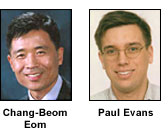MADISON, Wis., May 22, 2006 -- As scientists and engineers build devices at smaller and smaller scales, grasping the dynamics of  how materials behave when they are subjected to electrical signals, sound and other manipulations has proven to be beyond the reach of standard scientific techniques, given the ultrafast reaction time of the tiny materials. But now a team of University of Wisconsin-Madison researchers has found a way to time such effects at the nanometer scale, in essence clocking the movements of atoms as they are manipulated using electric fields.
how materials behave when they are subjected to electrical signals, sound and other manipulations has proven to be beyond the reach of standard scientific techniques, given the ultrafast reaction time of the tiny materials. But now a team of University of Wisconsin-Madison researchers has found a way to time such effects at the nanometer scale, in essence clocking the movements of atoms as they are manipulated using electric fields.
The accomplishment is important because it gives scientists a way to probe another dimension of a material's structure at the nanometer scale, they said. Adding the dimension of time to their view of the nanoworld promises to enhance the ability to develop materials for improved memory applications in microelectronics of all kinds, among other things.
"Now we have a tool to look inside a device and see how it works at the spatial scale of nanometers and the time scale of nanoseconds," said Alexei Grigoriev, a UW-Madison postdoctoral fellow and the lead author of a paper on the research.
With the advent of nanotechnology, the ability to make devices and products on a scale measured in atoms has mushroomed. Products with elements fabricated at the nanoscale are on the market, and scientists continue to hone the technology, which has potential applications in areas ranging from digital electronics to toothpaste.
The traditional tools of nanotechnology -- the atomic force microscope and the scanning tunneling microscope -- enable scientists to see atoms, but not their response to events, which at that scale occur on the order of a billionth of a second or less. The ability to time events that occur in materials used in nanofabrication means that scientists can now view dynamic events at the atomic scale in key materials as they unfold. That ability, in turn, promises a more detailed understanding - and potential manipulation -- of the properties of those materials.
The UW-Madison work was accomplished using Argonne National Laboratory's Advanced Photon Source, a synchrotron light source capable of generating very tightly focused beams of x-rays. The researchers, in a group led by materials science and engineering Professor Paul Evans, focused a beam of x-rays on a thin film of a ferroelectric material grown by another Wisconsin group led by materials science and engineering Professor Chang-Beom Eom. The x-rays, according to Grigoriev, are delivered to the sample in fast pulses over an area no larger than hundreds of nanometers, or one ten-millionth of a meter.
Ferroelectric materials respond to electric fields by expanding or contracting their crystal lattice structures. Ferroelectric materials also exhibit the property of remnant polarization, where atoms are rearranged in response to electrical signals. This property allows tiny ferroelectric crystals to be used as elements of digital memories.
"Physically, the atoms switch position," Grigoriev said. "And as devices are pushed to smaller sizes, they must switch in extremely short times. It requires new tools to see those dynamics."
Using the x-rays from the Advanced Photon Source and measuring how the x-rays were reflected as the atoms in the material switched positions, the researchers were able to clock the event. As a material is subjected to the x-rays and the electrical signals, "You can see in time how the crystal structure (of the material) changes as the switching polarization propagates through the lattice," Grigoriev said.
The technique developed by Evans, Grigoriev and their colleagues is a combination of two existing techniques, making the technology easily accessible to science. It might also be applied to studies of phenomena such as magnetism and heat dissipation in microelectronic structures, they said.
In addition to Evans, Eom, and Grigoriev, authors of the paper, reported in the May 12 edition of the journal Physical Review Letters, include Dal-Hyun Do and Dong Min Kim of UW-Madison and Bernhard Adams and Eric M. Dufresne of Argonne National Laboratory. For more information, visit: www.wisc.edu